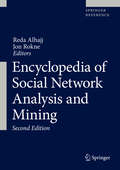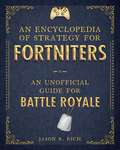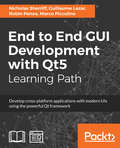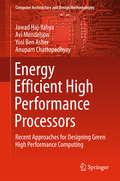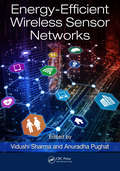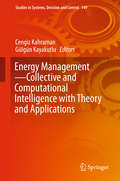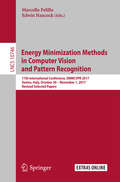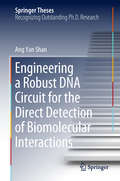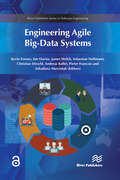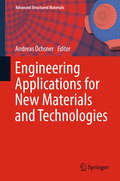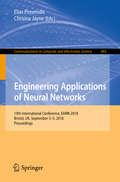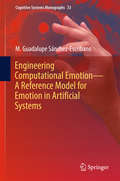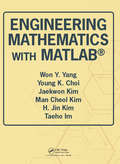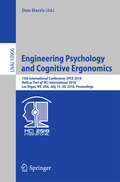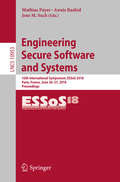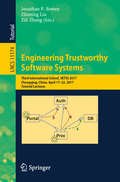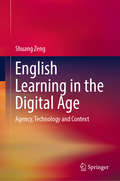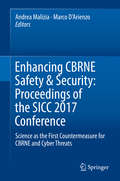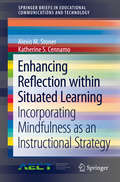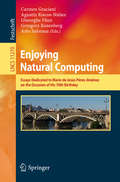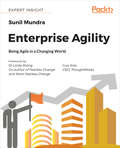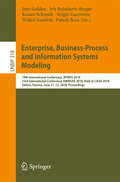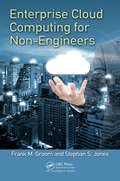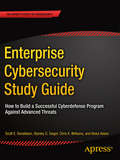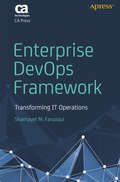- Table View
- List View
Encyclopedia of Social Network Analysis and Mining
by Reda Alhajj Jon RokneSocial Network Analysis and Mining Encyclopedia (ESNAM) is the first major reference work to integrate fundamental concepts and research directions in the areas of social networks and applications to data mining. The second edition of ESNAM is a truly outstanding reference appealing to researchers, practitioners, instructors and students (both undergraduate and graduate), as well as the general public. This updated reference integrates all basics concepts and research efforts under one umbrella. Coverage has been expanded to include new emerging topics such as crowdsourcing, opinion mining, and sentiment analysis. Revised content of existing material keeps the encyclopedia current. The second edition is intended for college students as well as public and academic libraries. It is anticipated to continue to stimulate more awareness of social network applications and research efforts.The advent of electronic communication, and in particular on-line communities, have created social networks of hitherto unimaginable sizes. Reflecting the interdisciplinary nature of this unique field, the essential contributions of diverse disciplines, from computer science, mathematics, and statistics to sociology and behavioral science, are described among the 300 authoritative yet highly readable entries. Students will find a world of information and insight behind the familiar façade of the social networks in which they participate. Researchers and practitioners will benefit from a comprehensive perspective on the methodologies for analysis of constructed networks, and the data mining and machine learning techniques that have proved attractive for sophisticated knowledge discovery in complex applications. Also addressed is the application of social network methodologies to other domains, such as web networks and biological networks.
An Encyclopedia of Strategy for Fortniters: An Unofficial Guide for Battle Royale (Encyclopedia for Fortniters #1)
by Jason R. RichThe Ultimate Unofficial Encyclopedia for Fortniters is a full-color, easy-to-read, unofficial reference tool that explains—from “A” to “Z”—everything players need to know in order to consistently win matches and successfully control their characters. <P><P>The Ultimate Unofficial Encyclopedia for Fortniters provides a comprehensive overview of the game—making it easier for first-time players to quickly get acclimated with the game—while, at the same time, it introduces more experienced players to countless advanced tips and strategies that will allow them to quickly improve their skills and survival rates. The tips and strategies included are related to safe exploration, creative building, offensive and defensive fighting techniques, and cunning survival skills. <P><P>Each of the more than one hundred topics covered within The Ultimate Unofficial Encyclopedia for Fortniters includes a detailed description, full-color screenshots, and appropriate tips and strategies that apply to the current and future versions of the game. This book is a must-read guide and information-packed resource for every Fortnite: Battle Royale player.
End to End GUI Development with Qt5: Develop cross-platform applications with modern UIs using the powerful Qt framework
by Nicholas Sherriff Guillaume Lazar Robin Penea Marco PiccolinoLearn the complete Qt ecosystem and its tools and build UIs for mobile and desktop applicationsKey FeaturesUnleash the power of the latest Qt 5.9 with C++14Easily compile, run, and debug your applications from the powerful Qt Creator IDEBuild multi-platform projects that target Android, iOS, Windows, MacOS, Linux, and moreBook DescriptionQt 5.9 is an application development framework that provides a great user experience and develops full-capability applications with Qt Widgets, QML, and even Qt 3D. This learning path demonstrates the power and flexibility of the Qt framework for desktop application development and shows how you can write an application once and deploy it to multiple operating systems. It will address all the challenges while developing cross-platform applications with the Qt framework.This course will give you a better understanding of the Qt framework and tools to resolve serious issues such as linking, debugging, and multithreading. It will also upskill you by explaining how to create a to-do-style app and taking you through all the stages in building a successful project. You will build a suite of apps; while developing these apps, you’ll deepen your knowledge of Qt Quick's layout systems, and see Qt 3D and widgets in action. The next project will be in the industrial and agricultural sectors: making sense of sensor data via a monitoring system. Your apps should run seamlessly across devices and operating systems such as Android, iOS, Windows, or Mac, and be cost-effective by integrating with existing web technologies. You take the role of lead developer and prototype a monitoring system. In doing so, you’ll get to know Qt's Bluetooth and HTTP APIs, as well as the Charts and Web Engine UI modules. These projects will help you gain a holistic view of the Qt framework.What you will learnInstall and configure the Qt Framework and Qt Creator IDEImplement a rich user interface with QMLLearn the fundamentals of QtTest and how to integrate unit testingCreate stunning UIs with Qt Widget and Qt QuickDevelop powerful, cross-platform applications with the Qt frameworkDesign GUIs with Qt Designer and build a library in it for UI previewsBuild a desktop UI with widgets and DesignerGet familiar with multimedia components to handle visual input and outputWho this book is forThis book will appeal to developers and programmers who would like to build GUI-based applications. Knowledge of C++ is necessary and a basic familiarity with Qt would be helpful.
Energy Efficient High Performance Processors: Recent Approaches For Designing Green High Performance Computing (Computer Architecture and Design Methodologies)
by Jawad Haj-Yahya Avi Mendelson Yosi Ben Asher Anupam ChattopadhyayThis book explores energy efficiency techniques for high-performance computing (HPC) systems using power-management methods. Adopting a step-by-step approach, it describes power-management flows, algorithms and mechanism that are employed in modern processors such as Intel Sandy Bridge, Haswell, Skylake and other architectures (e.g. ARM). Further, it includes practical examples and recent studies demonstrating how modem processors dynamically manage wide power ranges, from a few milliwatts in the lowest idle power state, to tens of watts in turbo state. Moreover, the book explains how thermal and power deliveries are managed in the context this huge power range. The book also discusses the different metrics for energy efficiency, presents several methods and applications of the power and energy estimation, and shows how by using innovative power estimation methods and new algorithms modern processors are able to optimize metrics such as power, energy, and performance. Different power estimation tools are presented, including tools that break down the power consumption of modern processors at sub-processor core/thread granularity. The book also investigates software, firmware and hardware coordination methods of reducing power consumption, for example a compiler-assisted power management method to overcome power excursions. Lastly, it examines firmware algorithms for dynamic cache resizing and dynamic voltage and frequency scaling (DVFS) for memory sub-systems.
Energy-Efficient Wireless Sensor Networks
by Vidushi Sharma Anuradha PughatThe advances in low-power electronic devices integrated with wireless communication capabilities are one of recent areas of research in the field of Wireless Sensor Networks (WSNs). One of the major challenges in WSNs is uniform and least energy dissipation while increasing the lifetime of the network. This is the first book that introduces the energy efficient wireless sensor network techniques and protocols. The text covers the theoretical as well as the practical requirements to conduct and trigger new experiments and project ideas. The advanced techniques will help in industrial problem solving for energy-hungry wireless sensor network applications.
Energy Management—Collective and Computational Intelligence with Theory and Applications: Collective And Computational Intelligence With Theory And Applications (Studies In Systems, Decision And Control #149)
by Cengiz Kahraman Gülgün KayakutluThis book presents a selection of recently developed collective and computational intelligence techniques, which it subsequently applies to energy management problems ranging from performance analysis to economic analysis, and from strategic analysis to operational analysis, with didactic numerical examples. As a form of intelligence emerging from the collaboration and competition of individuals, collective and computational intelligence addresses new methodological, theoretical, and practical aspects of complex energy management problems. The book offers an excellent reference guide for practitioners, researchers, lecturers and postgraduate students pursuing research on intelligence in energy management. The contributing authors are recognized researchers in the energy research field.
Energy Minimization Methods in Computer Vision and Pattern Recognition: Second International Workshop, Emmcvpr'99, York, Uk, July 26-29, 1999, Proceedings (Lecture Notes in Computer Science #1654)
by Marcello Pelillo Edwin HancockThis volume constitutes the refereed proceedings of the 11th International Conference on Energy Minimization Methods in Computer Vision and Pattern Recognition, EMMCVPR 2017, held in Venice, Italy, in October/November 2017. The 37 revised full papers were carefully reviewed and selected from 51 submissions. The papers are organized in topical sections on Clustering and Quantum Methods; Motion and Tracking; Image Processing and Segmentation; Color, Shading and Reflectance of Light; Propagation and Time-evolution; and Inference, Labeling, and Relaxation.
Engineering a Robust DNA Circuit for the Direct Detection of Biomolecular Interactions (Springer Theses)
by Ang Yan ShanThis book provides essential insights into designing a localized DNA circuit to promote the rate of desired hybridization reactions over undesired leak reactions in the bulk solution. The area of dynamic DNA nanotechnology, or DNA circuits, holds great promise as a highly programmable toolbox that can be used in various applications, including molecular computing and biomolecular detection. However, a key bottleneck is the recurring issue of circuit leakage. The assembly of the localized circuit is dynamically driven by the recognition of biomolecules – a different approach from most methods, which are based on a static DNA origami assembly. The design guidelines for individual reaction modules presented here, which focus on minimizing circuit leakage, are established through NUPACK simulation and tested experimentally – which will be useful for researchers interested in adapting the concepts for other contexts. In the closing section, the design concepts are successfully applied to the biomolecular sensing of a broad range of targets including the single nucleotide mutations, proteins, and cell surface receptors.
Engineering Agile Big-Data Systems (River Publishers Series In Software Engineering Ser.)
by Kevin Feeney Jim Davies James WelchTo be effective, data-intensive systems require extensive ongoing customisation to reflect changing user requirements, organisational policies, and the structure and interpretation of the data they hold. Manual customisation is expensive, time-consuming, and error-prone. In large complex systems, the value of the data can be such that exhaustive testing is necessary before any new feature can be added to the existing design. In most cases, the precise details of requirements, policies and data will change during the lifetime of the system, forcing a choice between expensive modification and continued operation with an inefficient design.Engineering Agile Big-Data Systems outlines an approach to dealing with these problems in software and data engineering, describing a methodology for aligning these processes throughout product lifecycles. It discusses tools which can be used to achieve these goals, and, in a number of case studies, shows how the tools and methodology have been used to improve a variety of academic and business systems.
Engineering Applications for New Materials and Technologies (Advanced Structured Materials #85)
by Andreas ÖchsnerThis book discusses the expertise, skills, and techniques needed for the development of new materials and technologies. It focuses on finite element and finite volume methods that are used for engineering simulations, and present many state-of-the-art applications and advances to highlight these methods’ importance. For example, modern joining technologies can be used to fabricate new compound or composite materials, even those formed from dissimilar component materials. These composite materials are often exposed to harsh environments, must deliver specific characteristics, and are primarily used in automotive and marine technologies, i.e., ships, amphibious vehicles, docks, offshore structures, and even robots. To achieve the desired material performance, computer-based engineering tools are widely used for simulation, data evaluation, and design processes.
Engineering Applications of Neural Networks: 19th International Conference, EANN 2018, Bristol, UK, September 3-5, 2018, Proceedings (Communications in Computer and Information Science #893)
by Elias Pimenidis Chrisina JayneThis book constitutes the refereed proceedings of the 19th International Conference on Engineering Applications of Neural Networks, EANN 2018, held in Bristol, UK, in September 2018.The 16 revised full papers and 5 revised short papers presented were carefully reviewed and selected from 39 submissions. The papers are organized in topical sections on activity recognition, deep learning, extreme learning machine, machine learning applications, predictive models, fuzzy and recommender systems, recurrent neural networks, spiking neural networks.
Engineering Computational Emotion - A Reference Model for Emotion in Artificial Systems
by M. Guadalupe Sánchez-EscribanoThis book provides a new perspective on emotion in artificial systems. It presents an insightful explanation of how emotion might emerge deep inside the systems, and emotional behaviour could be seen as a consequence of their internal management. The final approach attempts to account for a range of events associated with emotion, from functional and behavioural features to aspects related to the dynamics and the development of feeling. The book provides a theoretical foundation for engineering and designing computational emotion as a framework for developing future adaptive systems. It includes a painstaking analysis of the rationales for the features of the final approach, including aspects from the fields of Artificial Intelligence, Psychology, the Cognitive Sciences and Model-based Systems. Synthesizing knowledge from a variety of disciplines, it ultimately presents a model conceptualization following the perspectives of Engineering and the Cognitive Sciences.
Engineering Mathematics with MATLAB
by Won Y. Yang Young K. Choi Jaekwon Kim Man Cheol Kim H. Jin Kim Taeho ImThe aim of this book is to help the readers understand the concepts, techniques, terminologies, and equations appearing in the existing books on engineering mathematics using MATLAB. Using MATLAB for computation would be otherwise time consuming, tedious and error-prone. The readers are recommended to have some basic knowledge of MATLAB.
Engineering Psychology and Cognitive Ergonomics: 15th International Conference, EPCE 2018, Held as Part of HCI International 2018, Las Vegas, NV, USA, July 15-20, 2018, Proceedings (Lecture Notes in Computer Science #10906)
by Don HarrisThis book constitutes the proceedings of the 14th International Conference on Engineering Psychology and Cognitive Ergonomics, EPCE 2018, held as part of the 20th International Conference, HCI International 2018, which took place in Las Vegas, Nevada, in July 2018. The total of 1171 papers and 160 posters included in the 30 HCII 2018 proceedings volumes was carefully reviewed and selected from 4346 submissions. EPCE 2018 includes a total of 57 papers; they were organized in topical sections named: mental workload and human error; situation awareness, training and team working; psychophysiological measures and assessment; interaction, cognition and emotion; and cognition in aviation and space.
Engineering Secure Software and Systems: 10th International Symposium, ESSoS 2018, Paris, France, June 26-27, 2018, Proceedings (Lecture Notes in Computer Science #10953)
by Awais Rashid Mathias Payer Jose M. SuchThis book constitutes the refereed proceedings of the 10th International Symposium on Engineering Secure Software and Systems, ESSoS 2018, held in Paris, France, in June 2018. The 10 papers, consisting of 7 regular and 3 idea papers, were carefully reviewed and selected from 26 submissions. They focus on the construction of secure software, which is becoming an increasingly challenging task due to the complexity of modern applications, the growing sophistication of security requirements, the multitude of available software technologies, and the progress of attack vectors.
Engineering Trustworthy Software Systems: Third International School, SETSS 2017, Chongqing, China, April 17–22, 2017, Tutorial Lectures (Lecture Notes in Computer Science #11174)
by Jonathan P. Bowen Zhiming Liu Zili ZhangThis volume contains a record of some of the lectures and seminars delivered at the Third International School on Engineering Trustworthy Software Systems (SETSS 2017), held in April 2017 at Southwest University in Chongqing, China. The six contributions included in this volume provide an overview of leading-edge research in methods and tools for use in computer system engineering. They have been distilled from six original courses delivered at the school on topics such as: rely/guarantee thinking; Hoare-style specification and verification of object-oriented programs with JML; logic, specification, verification, and interactive proof; software model checking with Automizer; writing programs and proofs; engineering self-adaptive software-intensive systems; and with an additional contribution on the challenges for formal semantic description. The material is useful for postgraduate students, researchers, academics, and industrial engineers, who are interested in the theory and practice of methods and tools for the design and programming of trustworthy software systems.
English Learning in the Digital Age: Agency, Technology and Context
by Shuang ZengMoving beyond the ‘Web 2.0’ and ‘digital native’ rhetoric, this book addresses the complex experiences of learners of English as a foreign language (EFL) in a world embedded with interactive and participatory technologies. Adopting a sociocultural perspective, it investigates EFL learners’ behaviours concerning digital technology, and guides exploration into their contextually mediated choices and learning practices in the ‘2.0’ era.The argument is developed on the basis of the findings of a mixed sequential study that focused on 1485 Chinese undergraduates’ use and non-use of online tools and applications outside the English classroom. Particular attention is paid to the role of context and agency when understanding their learning choices and behaviours in the context of digital technology. In particular, the book acknowledges the explanatory power of agency in the minority instances of ‘good practices’ among these EFL learners. At the same time it demonstrates that for most learners, use of the current web is limited and mostly non-interactive. The barriers to ‘2.0’ transfer are largely contextual and the so-called ‘communicative opportunities’ and ‘participatory culture’ in particular did not fit into the learners’ sociocultural context of (language) learning.Overall, the compelling argument proposes that the technology-facilitated changes in EFL practices are a ‘bottom up’ process that is taking place in day-to-day situations and constrained by the learning context within which the learner is situated. Based on these arguments, the book provides a framework that challenges the existing beliefs about (language) learning with online technology, and that contributes to our understanding of how context mediates EFL learners’ behaviours surrounding digital technologies. It is a valuable resource for teachers, researchers and policy makers, providing them with insights into using digital technology to stimulate ‘good learning practices’ outside the classroom.
Enhancing CBRNE Safety & Security: Science As The First Countermeasure For Cbrne And Cyber Threats
by Marco D’Arienzo Andrea MaliziaThis book presents the proceedings of SICC 2017, a conference devoted to promoting the dissemination of the different methodologies, techniques, theories, strategies, technologies and best practices on the prevention and mitigation of CBRNE risks. As the first scientific international conference on safety & security issues in the CBRNE field, SICC 2017 attracted contributions resulting from fruitful inter-professional collaborations between university and military experts, specialized operators, decision makers and the industry. As such, these proceedings are primarily intended for academics and professionals from public, private and military entities. It is the first trans-disciplinary collection of scientific papers from the numerous fields related to CBRNE.
Enhancing Reflection within Situated Learning: Incorporating Mindfulness As An Instructional Strategy (Springerbriefs In Educational Communications And Technology Ser.)
by Alexis M. Stoner Katherine S. CennamoThis innovative brief provides guidance on promoting reflection in situated learning by incorporating mindfulness strategies, tapping into a surge of research interest in exploring mindfulness as an instructional strategy associated with positive learning outcomes. It illustrates the benefits of continuous reflection within situated learning and how mindfulness can be incorporated before, during, and after the learning experience to enhance the reflective experience. Critically, the authors present a new conceptual model that synthesizes theories and methods from three different areas of study—mindfulness, situated learning, and reflection— to provide a new perspective and instructional approach that has great potential to positively impact outcomes in situated learning.Among the other topics covered:• Strategies for reflection in situated learning.• Strategies for reflection-in-action in situated learning.• Mindfulness strategies for situated learning.• A conceptual model incorporating mindfulness to enhance reflection.Enhancing Reflection within Situated Learning is an exciting and pioneering resource that offers practical guidance to educators and instructional designers interested in incorporating methods and approaches for integrating mindfulness and reflection across instructional environments.
Enjoying Natural Computing: Essays Dedicated to Mario de Jesús Pérez-Jiménez on the Occasion of His 70th Birthday (Lecture Notes in Computer Science #11270)
by Carmen Graciani Agustín Riscos-Núñez Gheorghe Păun Grzegorz Rozenberg Arto SalomaaThis Festschrift is in honor of Mario de Jesús Pérez-Jiménez, Professor in the Department of Computer Science of University of Seville, Spain, on the occasion of his 70th birthday. The title of this volume reflects both his main research area, viz., Natural Computing, and the guiding principle of his functioning: “once you choose to do something, enjoy doing it".The respect that Professor Mario de Jesús Pérez-Jiménez enjoys in the scientific community was well demonstrated by the enthusiastic response received to the request to contribute to this book. The contributions by more than 70 authors from 15 countries cover a wide spectrum of research areas and reflect well the broad range of research interests of Professor Mario de Jesús Pérez-Jiménez. The research areas presented in this Festschrift include membrane computing, spiking neural networks, phylogenetic networks, ant colonies optimization, workbench for biocomputing, reaction systems, entropy of computation, rewriting systems, and insertion-deletion systems.
Enterprise Agility: Being Agile in a Changing World
by Sunil MundraEnterprise Agility is practical framework for enhancing Agility and equipping your company with the tools to survive. Key Features● Prepare your company to navigate the rapidly-moving business world● Enhance Agility in every component of your organization● Build a framework that meets the unique requirements of your enterpriseBook DescriptionThe biggest challenge enterprises face today is dealing with fast-paced change in all spheres of business. Enterprise Agility shows how an enterprise can address this challenge head on and thrive in the dynamic environment. Avoiding the mechanistic construction of existing enterprises that focus on predictability and certainty, Enterprise Agility delivers practical advice for responding and adapting to the scale and accelerating pace of disruptive change in the business environment.Agility is a fundamental shift in thinking about how enterprises work to effectively deal with disruptive changes in the business environment. The core belief underlying agility is that enterprises are open and living systems. These living systems, also known as complex adaptive systems (CAS), are ideally suited to deal with change very effectively.Agility is to enterprises what health is to humans. There are some foundational principles that can be broadly applied, but the definition of healthy is very specific to each individual. Enterprise Agility takes a similar approach with regard to agility: it suggests foundational practices to improve the overall health of the body—culture, mindset, and leadership—and the health of its various organs: people, process, governance, structure, technology, and customers. The book also suggests a practical framework to create a plan to enhance agility.What you will learnDrive agility-oriented change across the enterpriseUnderstand why agility matters (more than ever) to modern enterprises Adopt and influence an Agile mindset in your teams and in your organization Understand the concept of a CAS and how to model enterprise and leadership behaviors on CAS characteristics to enhance enterprise agility Understand and convey the differences between Agile and true enterprise agility Create an enterprise-specific action plan to enhance agility Become a champion for enterprise agilityRecognize the advantages and challenges of distributed teams, and how Agile ways of working can remedy the rough spotsEnable and motivate your IT partners to adopt Agile ways of workingWho this book is forEnterprise Agility is a tool for anyone with the motivation to influence outcomes in an enterprise, who aspires to improve Agility. Readers from the following backgrounds will benefit: chief executive officer, chief information officer, people/human resource director, information technology director, head of change program, head of transformation, and Agile coach/consultant.
Enterprise, Business-Process and Information Systems Modeling: 19th International Conference, BPMDS 2018, 23rd International Conference, EMMSAD 2018, Held at CAiSE 2018, Tallinn, Estonia, June 11-12, 2018, Proceedings (Lecture Notes in Business Information Processing #318)
by Jens Gulden Iris Reinhartz-Berger Rainer Schmidt Sérgio Guerreiro Wided Guédria Palash BeraThis book constitutes the proceedings of two events held at the CAiSE conference and relating to the areas of enterprise, business process and information systems modeling: The 19th International Conference on Business Process Modeling, Development and Support, BPMDS 2018, and the 23rd International Conference on Evaluation and Modeling Methods for Systems Analysis and Development, EMMSAD 2018. The conferences took place in Tallinn, Estonia, in June 2018. The 13 papers accepted for BPMDS were carefully reviewed and selected from 29 submissions; for EMMSAD 6 papers out of 13 submissions were accepted for publication. For BPMDS 2018, the papers were organized in topical sections as follows: context-awareness in business processes; automatic analysis of business processes; advanced approaches for business process modeling; evaluation of business process modeling techniques; an experience report on modeling collaborative processes. For EMMSAD 2018, the six related papers are listed without further sections.
Enterprise Cloud Computing for Non-Engineers (Technology for Non-Engineers)
by Frank Groom Stephan JonesThis book provides a technical description of cloud computing technologies, covering cloud infrastructure and platform services. It then addresses the basics of operating a Cloud computing data center, the services offered from Cloud providers, the carrier role in connecting users to data centers, and the process of interconnecting Cloud data centers to form a flexible processing unit. It also describes how cloud computing has made an impact in various industries and provides emerging technologies that are critical within each industry. Lastly, this book will address security requirements and provide the best practices in securing data.
Enterprise Cybersecurity Study Guide: How To Build A Successful Cyberdefense Program Against Advanced Threats
by Scott E. Donaldson Stanley G. Siegel Chris K. Williams Abdul AslamUse the methodology in this study guide to design, manage, and operate a balanced enterprise cybersecurity program that is pragmatic and realistic in the face of resource constraints and other real-world limitations. This guide is an instructional companion to the book Enterprise Cybersecurity: How to Build a Successful Cyberdefense Program Against Advanced Threats. The study guide will help you understand the book’s ideas and put them to work. The guide can be used for self-study or in the classroom.Enterprise cybersecurity is about implementing a cyberdefense program that will succeed in defending against real-world attacks. While we often know what should be done, the resources to do it often are not sufficient. The reality is that the Cybersecurity Conundrum—what the defenders request, what the frameworks specify, and what the budget allows versus what the attackers exploit—gets in the way of what needs to be done. Cyberattacks in the headlines affecting millions of people show that this conundrum fails more often than we would prefer.Cybersecurity professionals want to implement more than what control frameworks specify, and more than what the budget allows. Ironically, another challenge is that even when defenders get everything that they want, clever attackers are extremely effective at finding and exploiting the gaps in those defenses, regardless of their comprehensiveness. Therefore, the cybersecurity challenge is to spend the available budget on the right protections, so that real-world attacks can be thwarted without breaking the bank.People involved in or interested in successful enterprise cybersecurity can use this study guide to gain insight into a comprehensive framework for coordinating an entire enterprise cyberdefense program.What You’ll Learn Know the methodology of targeted attacks and why they succeed Master the cybersecurity risk management process Understand why cybersecurity capabilities are the foundation of effective cyberdefenses Organize a cybersecurity program's policy, people, budget, technology, and assessment Assess and score a cybersecurity program Report cybersecurity program status against compliance and regulatory frameworks Use the operational processes and supporting information systems of a successful cybersecurity program Create a data-driven and objectively managed cybersecurity program Discover how cybersecurity is evolving and will continue to evolve over the next decade Who This Book Is For Those involved in or interested in successful enterprise cybersecurity (e.g., business professionals, IT professionals, cybersecurity professionals, and students). This guide can be used in a self-study mode. The book can be used by students to facilitate note-taking in the classroom and by Instructors to develop classroom presentations based on the contents of the original book, Enterprise Cybersecurity: How to Build a Successful Cyberdefense Program Against Advanced Threats.
Enterprise DevOps Framework: Transforming It Operations
by Shamayel M. FarooquiTransform your IT organization from one weighed down by set practices to one with a DevOps culture and a cloud-first strategy that is optimized by automation and other lean practices. In this engaging read, you will discover the opportunities, challenges, lessons, and rewards that CA Technologies encountered when making their agile and DevOps transformation.In Enterprise DevOps Framework author Shamayel Farooqui shows you how agile adoption will enable your organization to stay ahead in an ever-changing business environment and meet your customers’ needs. He includes detailed references to key concepts such as agile, hybrid and cloud technology, infrastructure management, and process automation.What You’ll LearnEstablish the focus areas for your IT organizationPrepare for the challenges of transforming your enterprise to a DevOps, agile organizationKnow the key steps for executing an enterprise DevOps strategyBuild a strong team of DevOps individuals focused on improving the efficiency of your organization through Agile methodologies, automation, cloud adoption, and “infrastructure as code” practicesWho This Book Is For IT administrators, operational personnel, cloud professionals, DevOps professionals, human resources professionals, managers, and C-level staff
